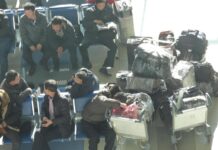Satellite images taken on May 14 and 15 show signs that the DPRK is preparing to hold a military parade in Pyongyang, according to an analysis by the Korean edition of Voice of America (VOA).
The photos show a line of 50 to 100 army vehicles parked at a normally empty military training area near Pyongyang’s Mirim Air Base, also known as K-24 Air Base. The site is where the regime usually stores military equipment and rehearses formations before its parades, as it has replicas of Kim Il Sung Square – the actual site of the parade – and the central grandstand where the leader will take his seat. Currently, the training area is about 40% filled up. The remaining space and lack of troop movements indicate that preparations for the ceremony are still in the early stages.
It is not yet known on what occasion the parade will be held. According to VOA, two important dates could be considered in the coming months: the 70th anniversary of “Victory Day” on July 27 in honor of the North’s defeat of the U.S. invasion of its territory, as it claims, or the 75th “Republic Day” on Sept. 9 – the day the DPRK was founded after the 1950-53 Korean War.
Parading of new weapon systems
North Korea’s military parades are always of great interest to observers, as the regime often uses them as an opportunity to showcase new military equipment and recently acquired weapons systems.
Earlier this year, North Korea held a nighttime military parade on Feb. 8 to celebrate the 75th anniversary of the Korean People’s Army – a day commonly known as “Military Day.“ Television and press featured almost a dozen advanced intercontinental ballistic missiles in the biggest display yet, some of which are potentially capable of overwhelming existing US homeland missile defenses and exposing US vulnerability to missile attacks, according to 38 North.
Under the eyes of leader Kim Jong-Un, his wife Ri Sol-Ju, and his daughter Kim Ju Ae, the military presented, among others, 12 Hwasong-17 intercontinental ballistic missiles (ICBM). They are currently North Korea’s biggest missiles and likely the largest road-mobile, liquid-fuelled ICBMs in the world. The Hwasong-17 was first tested in March 2022 and is believed to be capable of delivering a nuclear warhead to targets anywhere in the US. In addition to an array of other tactical missiles and long-range cruise missiles, North Korea also showed off a mockup of a new solid-fueled ICBM, which, if it were to become operational, would give Pyongyang a more mobile and barely detectable nuclear missile.
How do rehearsals work in North Korea?
North Korean troops train and practice complicated formations for months in advance in order to perform flawlessly. The excessive and months-long training sessions can be extremely hard on the often malnourished soldiers. As a result, it is quite common for people to collapse from exhaustion and illness during parade rehearsals. During the drills for the parade in February, some participants even had to be hospitalized.
The right to order a parade is reserved exclusively for North Korean dictator Kim Jong-Un. According to 38 North, preparations for North Korean military parades have followed a consistent pattern for decades. They usually begin four to six months in advance with the buildup of equipment and vehicles at the Mirim parade training facility, as is currently being observed.
The first military personnel – specially selected infantry, light artillery and anti-aircraft units, as well as parade teams – are called in one to three months prior and begin rehearsing formations, timings, music and choreography. As the day of the parade approaches, more units are incorporated into the practice sessions. Both the equipment that accompanies the units and a “tent city,” consisting of housing, food, medical, logistics and maintenance components, usually become visible on satellite imagery at that time.
The week before the event consists of final preparations: Parade uniforms and equipment are issued, and full-dress rehearsals take place regularly – usually at night to limit observation.
On the day of the parade, Kim Jong Un arrives at the grandstand at 10 AM, where he is greeted by a commander of the Korean People’s Army Honor Guard Company. Respected citizens, Pyongyang residents, army veterans and diplomats watch the parade from stands erected around Kim Il-Sung Square, which crosses the Okryu Bridge and marches along Sungri Street into the center of Pyongyang.
Edited by Robert Lauler.


















